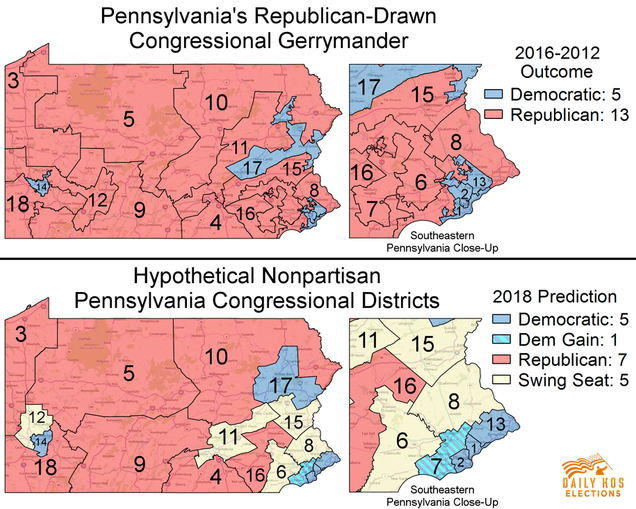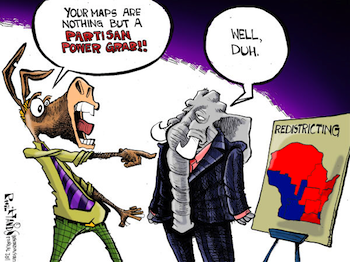By Mikayla Foster
Can Partisan Gerrymandering be Stopped?
Attention to partisan gerrymandering has heightened as the next wave of redistricting fast approaches and the Supreme Court’s 2017-2018 docket included two cases regarding the constitutionality of partisan gerrymander. Following the release of the 2020 census, states will set out to redraw their district maps. States redistrict at least every ten years. The 2010 redistricting results are described as the most extreme partisan gerrymandering in our country’s history. The 2010 maps have a heavy Republican partisan advantage, as evidenced by the 2012 election results with Republicans gaining a 234 to 201 seat advantage in the House of Representatives despite Democrats winning 1.5 million more votes than Republicans. The Republican partisan advantage has remained strong. The Brennan Center for Justice has predicted that in the 2018 midterm elections Democrats will need to win by a margin of nearly 11 points to gain a majority in the House of Representatives. Democrats, however, have not won by a margin this large since 1974. Following years of heavily gerrymandered districts, a supermajority of Americans have indicated support for the Supreme Court to bring an end to partisan gerrymandering, yet the Court failed to take action this year.
 Partisan gerrymandering is the carving of districts, into sometimes odd shapes, to benefit a political party’s electoral prospects. The term gerrymandering was coined after Elbridge Gerry, a Massachusetts’s governor, in order to describe an irregularly shaped district that looked like a salamander in an 1812 redistricting map he signed into law. As a result, partisan gerrymandering has been a defining feature of “American politics since the early days of the Republic.” While racial gerrymandering is unconstitutional, the constitutionality of partisan gerrymandering is an open question, as the Supreme Court has never struck down a map for partisan gerrymander.
Partisan gerrymandering is the carving of districts, into sometimes odd shapes, to benefit a political party’s electoral prospects. The term gerrymandering was coined after Elbridge Gerry, a Massachusetts’s governor, in order to describe an irregularly shaped district that looked like a salamander in an 1812 redistricting map he signed into law. As a result, partisan gerrymandering has been a defining feature of “American politics since the early days of the Republic.” While racial gerrymandering is unconstitutional, the constitutionality of partisan gerrymandering is an open question, as the Supreme Court has never struck down a map for partisan gerrymander.
Partisan gerrymandering seems to fly in the face of democracy. Voting is a fundamental right and electing who you want to represent you in office is a fundamental part of democracy. Legislatures that scheme, plan, and manipulate maps to benefit one party over another can undermine the purpose of democracy. Some of this scheming, planning, and manipulating is self-interested as legislatures try to protect incumbents and create safe districts, but can also serve the purpose of entrenching a political party’s majority until the next redistricting cycle. Both parties, Republicans and Democrats, have enjoyed the benefit of partisan gerrymandering when given the opportunity.
While the Supreme Court has indicated that some level of partisan gerrymandering may be unconstitutional, it has yet to explain when the constitutional line has been crossed. This term, the Supreme Court took up the question of partisan gerrymandering for the first time in more than a decade. The two cases before the Supreme Court were Gill v. Whitford and Benisek v. Lamone. The Supreme Court was asked to answer when partisan gerrymander crosses the constitutional line. Gill v. Whitford challenged a statewide map that has been deemed among one of the worst partisan gerrymandered maps in the country, with a significant Republican partisan advantage. Benisek v. Lamone challenged one congressional district in Maryland, with a significant Democratic partisan advantage. Some speculated that the Court took up both cases to deter an appearance that the Supreme Court prefers one party over the other. Another reason may be that the Wisconsin case was a challenge to a statewide map compared to the Maryland case challenging one congressional district.
The appellants attorney in Gill v. Whitford argued during oral arguments (see, page 62) that the Supreme Court is the only institution to put an end to partisan gerrymandering. The Court, however, sidestepped the entire issue by unanimously finding the Gill plaintiffs did not have standing, and that the challengers in Benisek had waited too long to seek an injunction blocking the district. The Supreme Court’s silence allows legislatures to continue to strategically gerrymander.
While the country waits on the Supreme Court to provide an answer on the constitutionality of partisan gerrymander, some states have attempted to take partisanship out of the process by using redistricting commissions, while others suggest that computers with algorithms should produce the maps. Yet, neither of these options individually seem to completely insulate redistricting from politics.
States have adopted redistricting commissions with the intention to remove partisanship from the redistricting process. However, this has often proved difficult to achieve, as finding non-partisan committee members is difficult and oftentimes the commission is appointed by partisan members, such as elected representatives and governors. States use different types of commissions and may only use a commission for redistricting the state map or congressional map. About 23 states use commissions for the state legislative maps and about 14 states use commissions for the congressional maps. The redistricting commissions can take the form of an advisory commission that makes suggestions to the legislature, a backup commission that draws the map if the legislature fails to redistrict, or as having the primary responsibility of drawing the map.
Even states that use independent redistricting commissions have had difficulties completely insulating the process from politics. For instance, in 2011, Arizona’s Independent Redistricting Commission chairwoman was removed by the Republican Governor and the Republican-controlled State Senate. The Governor accused the chairwoman of skewing the process for Democrats. The Arizona Supreme Court, however, reinstated the chairwoman and the United States Supreme Court upheld Arizona’s independent redistricting commission as a legitimate way to draw district maps. Although some states are moving toward redistricting commissions as a way to insulate the process from politics, these commissions are “only as independent as those who appoint it.”
While technological advances have been thought to help parties gerrymander more effectively, some suggest that similar technology could take politics out of the process with the proper algorithms. Brian Olson, a Massachusetts software engineer, wrote an algorithm to create “‘optimally compact’ equal-population congressional districts.” Olson prioritized the compactness requirement in an effort to reflect “actual neighborhoods” and because dramatically non-compact districts can be a “telltale sign of gerrymandering.” However, political scientists are skeptical about an algorithm prioritizing compactness, because it ignores other important factors, such as community of interest. Furthermore, someone needs to set the algorithm and there can be infinite map results. Thus, without very strict restrictions and guidelines, setting an algorithm and picking the map can still be an inherent gerrymander.
Removing politics completely from the redistricting process appears to be nearly impossible. Partisanship is deeply entrenched in the process, and dates back to even before the coined term “gerrymander.” Redistricting commissions do not always guarantee a partisan free redistricting effort, and while technology offers an alternative to human map drawing, humans are still making the final decision. Some combination of these efforts may help to lessen the amount of politics used in the redistricting process or lessen the appearance of partisanship, but are unlikely to completely end partisan gerrymandering all together.
 Mikayla Foster anticipates graduating from Boston University School of Law in May, 2019.
Mikayla Foster anticipates graduating from Boston University School of Law in May, 2019.
A Lackluster Response to the 64,000 Opioid Overdose Deaths Per Year
The Opioid Epidemic stands apart from past drug crises this country has experienced. Not only is this the deadliest drug crisis the country has experienced, this epidemic is a result of a “perfect storm.” A shift in the medical field to focusing on the treatment of pain changed opioid prescribing practices and encouraged an increase in marketing practices of opioid pharmaceutical companies, resulting in America being the world’s leader in opioid prescriptions. Congress, through the Bipartisan Task Force to Combat the Heroin Epidemic, made some progress addressing opioids during the Obama Administration, but with the change in administration the efforts seem stalled.
In 2015, doctors prescribed enough opioids to medicate every American around the clock for three weeks. Even as doctors started to prescribe fewer opioids, in 2016 enough opioids were prescribed to fill a bottle for every adult in America. The increase in opioid prescriptions came at the same time as there was a shortage of workers in addiction and recovery, allowing for only 10 percent of Americans with substance use disorder to receive the necessary treatment. This “perfect storm” created a massive swell in opioid addictions. As it became more difficult to obtain prescription opioids, addicts sought a stronger high and many turned to illegal opioids, such as heroin and fentanyl. Nearly 80 percent of Americans addicted to heroin started with misuse of prescription drugs.
The death of Philip Seymour Hoffman in 2014 from a heroin overdose put a spotlight on the crisis. Despite recognizing that there was a nation-wide epidemic, the country took a lackluster response and overdose deaths continued to spike. The National Center for Health Statistics, Centers for Disease Control and Prevention, and the National Institute on Drug Abuse have reported only an increase in the overdose deaths. The U.S. government estimated about 64,000 overdose deaths for 2016. With the epidemic claiming a record number of lives per day, all of the 2016 presidential candidates spoke about personal stories or plans of action for combatting the epidemic. Most of the candidates agreed that the federal government should provide resources to the states to help combat the epidemic with a focus on treatment. Some of the other candidates focused on stopping the flow of drugs coming across the border, including now President Donald Trump.
In March 2017, President Trump established the President’s Commission on Combating Drug Addiction and the Opioid Crisis. The Commission members include Former Governor Chris Christie of New Jersey, Governor Charlie Baker of Massachusetts, Governor Roy Cooper of North Carolina, Former Congressman Patrick Kennedy of Rhode Island, Professor Bertha Madras, and Florida Attorney General Pam Bondi. On November 1, 2017, the Commission issued a final report with more than 50 recommendations (see, page 7). They included increasing data sharing of state-based prescription drug monitoring programs, changing privacy regulations to allow healthcare providers easier access to information about patients with substance use disorder, equipping all law enforcement officers with naloxone, and enforcing the Mental Health Parity and Addiction Equity Act. In addition, the Commission recommended a national multi-media campaign to help fight the epidemic, more federal funding for the states, drug courts in every federal district court, and enhanced penalties for drug trafficking to reduce the supply of opioids.
Even prior to the issuance of the report, President Trump declared the Opioid Epidemic a public health emergency. The President stated “[t]he best way to prevent drug addiction and overdose is to prevent people from abusing drugs in the first place. If they don’t start, they won’t have a problem,” but until his 2019 budget proposal the President’s Administration failed to request funding to combat the epidemic. Congressman Patrick Kennedy, a vocal critic of the limited action taken by the President, explained, “[t]he emergency declaration has accomplished little because there’s no funding behind it. You can’t expect to stem the tide of a public health crisis that is claiming over 64,000 lives per year without putting your money where your mouth is.”
The President’s focus has been on increasing funding for law enforcement. On January 10, 2018, the President signed the INTERDICT Act which provides funding to U.S. Customs and Border Protection to assist with the detection and interception of illicit fentanyl. Increased enforcement may be part of the solution, but some Congressional leaders believe there is more than just one solution and have said the epidemic must be addressed on many fronts.
In 2015, Representatives Ann McLane Kuster and Frank Guinta from New Hampshire, a state that has the highest fentanyl overdose deaths per capita, created the Congressional Bipartisan Task Force to Combat the Heroin Epidemic. From its inception, the task force has gained members from both parties, and now has more than 100 members. The Task Force pushes a legislative agenda, as well as holds informational hearings. Under President Obama’s Administration, the Task Force was able to pass several pieces of legislation, including the 21st Century Cures Act, and the Comprehensive Addiction & Recovery Act (CARA). The CARA Act is currently the main source of funding for the opioid epidemic, but the funding will run out in 2018. In response to the “perfect storm” that created this epidemic, CARA has six pillars of response, including prevention, treatment, recovery, law enforcement, criminal justice reform, and overdose reversal.
On January 10, 2018, the Task Force released its 2018 legislative agenda. The agenda includes bills focusing on prevention, treatment, law enforcement, and prescribing practices. Several of the bills include federal funding and grants. After the Task Force called for an increase in funding to combat the epidemic, Congress passed $6 billion in the 2018 budget. Some have been critical of the amount of funds dedicated to the epidemic, and compared it to the $24 billion a year that was dedicated to addressing the HIV/AIDS crisis.
On February 9, 2018, Purdue Pharma, the maker of OxyContin, announced it had laid off employees whose job was direct promotion of the drug to doctors. Purdue Pharma is currently facing dozens of lawsuits for deceptive marketing practices. It is unclear if the company’s change in promotion practices will alter prescribing practices of doctors, who are already familiar with the drug. To make a significant impact on the epidemic, real change needs to happen outside of Purdue Pharma’s promoting practices.
The U.S. Surgeon General issued a public health advisory encouraging Americans to routinely carry naloxone on April 5, 2018, which is the first advisory issued since the 2005 warning against drinking alcohol while pregnant. Access to naloxone would come in part from the $6 billion in the 2018 budget which has allocated grants for naloxone so states can hand it out for free; however, there is also reliance on naloxone manufacturers keeping costs low. The Surgeon General explained that naloxone can be a “touch point that leads to recovery.” However, more in line with the Trump Administration, the Surgeon General believes that the involvement of law enforcement is necessary to solving the epidemic.
A tough-on-crime approach and focus on providing funding strictly for law enforcement, as President Trump has encouraged, is not the answer. The country responded to the crack cocaine drug crisis with a tough-on-crime approach and strict sentencing guidelines. That led to extraordinary incarceration rates, especially for African Americans, and failed to address the issue of addiction as a disease. The country should learn from its mistakes, take a more well-rounded approach, as suggested by the Surgeon General and the Bipartisan Task Force, and implement a long-term solution. Congress must not only provide funding for law enforcement, but should increase treatment and recovery for substance use disorder, implement better prescription drug monitoring programs, start country-wide drug court programs, and educate Americans and doctors about the disease of addiction and risk of opioids. People are dying every day in this country from opioid overdoses, and every time Congress delays we lose another life.
 Mikayla Foster anticipates graduating from Boston University School of Law in May 2019.
Mikayla Foster anticipates graduating from Boston University School of Law in May 2019.



